
This is an quirky borscht, using a quirky beet. You can leave the veggies in big chunks because they'll be pureed.
1 pound gold beets
2 quarts water, divided
1 parsnip, trimmed and cut in chunks
1 carrot, trimmed and cut in chunks
1 leek, cleaned, trimmed, and cut in chunks
3 cloves garlic, peeled
1 teaspoon salt
1/2 teaspoon black pepper
1 tablespoon finely chopped fresh rosemary
juice of half an orange
2 tablespoons balsamic vinegar
1. Bring one quart of water to a boil in a medium-sized saucepan. Add the beets, lower the heat, and cook for about 45 minutes.
2. Meanwhile, bring the other quart of water to a boil in another medium-sized saucepan, then add the parsnip, carrot, leek, garlic, salt, pepper and rosemary. Lower the heat and cook on a medium-low flame for about 45 minutes.
3. Take a beet out of the pot with a pair of tongs, run it under cold water, and test it to see if you can easily rub off the skin. If you can, peel all of the beets this way, then cut them into chunks. If you can't return it to the pot, cook it for another 5-10 minutes, then try again.
4. Add the peeled, chunked beets to the remaining veggies, along with the orange juice and balsamic vinegar.
5. Drain the veggies and set aside the broth. Puree them in batches, adding liquid as needed. combine the remaining stock with the pureed veggies and serve.























